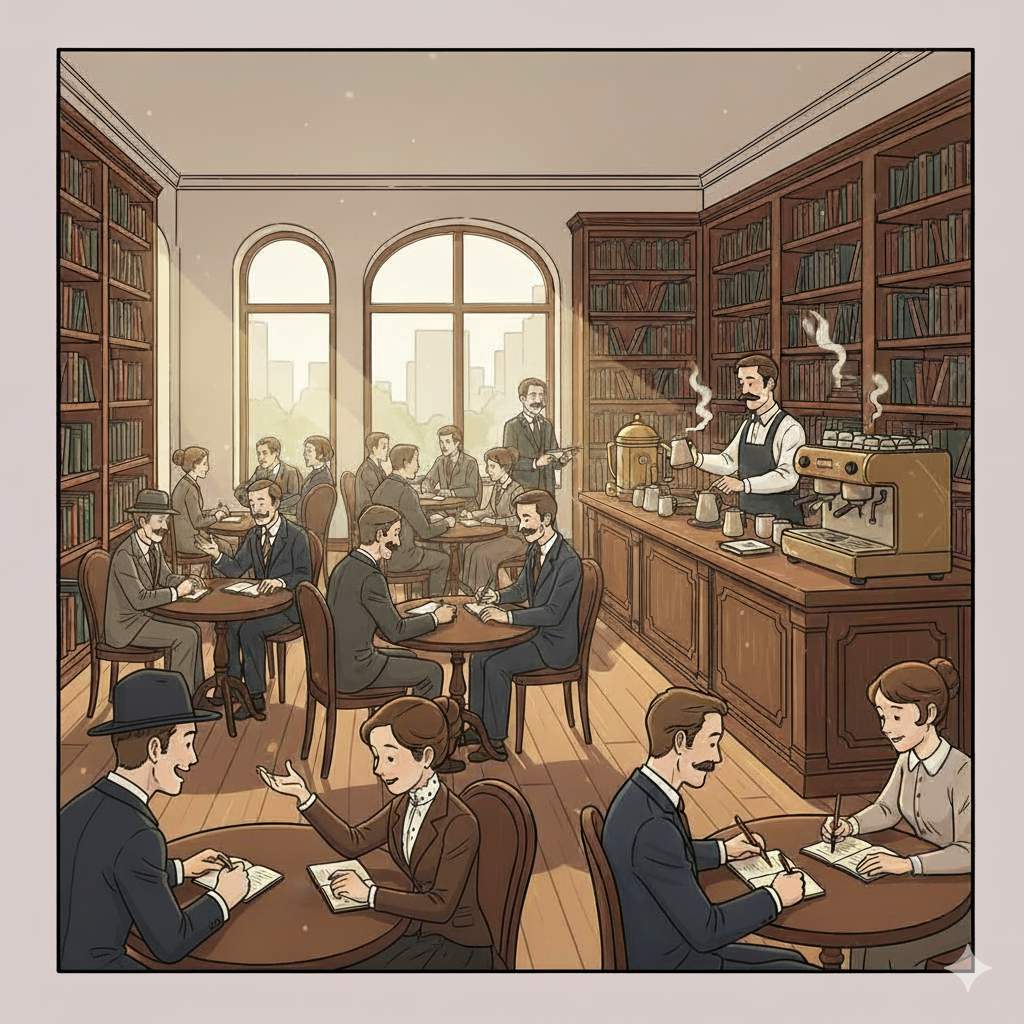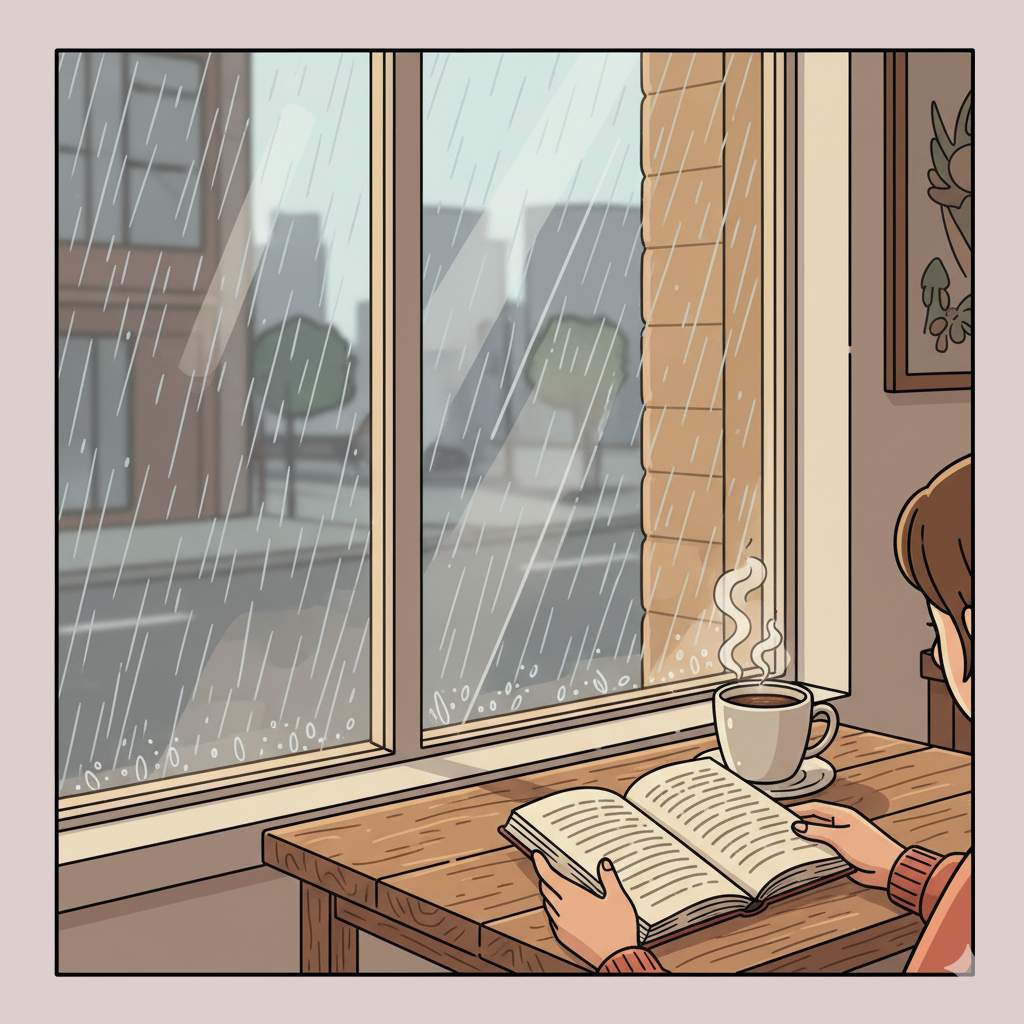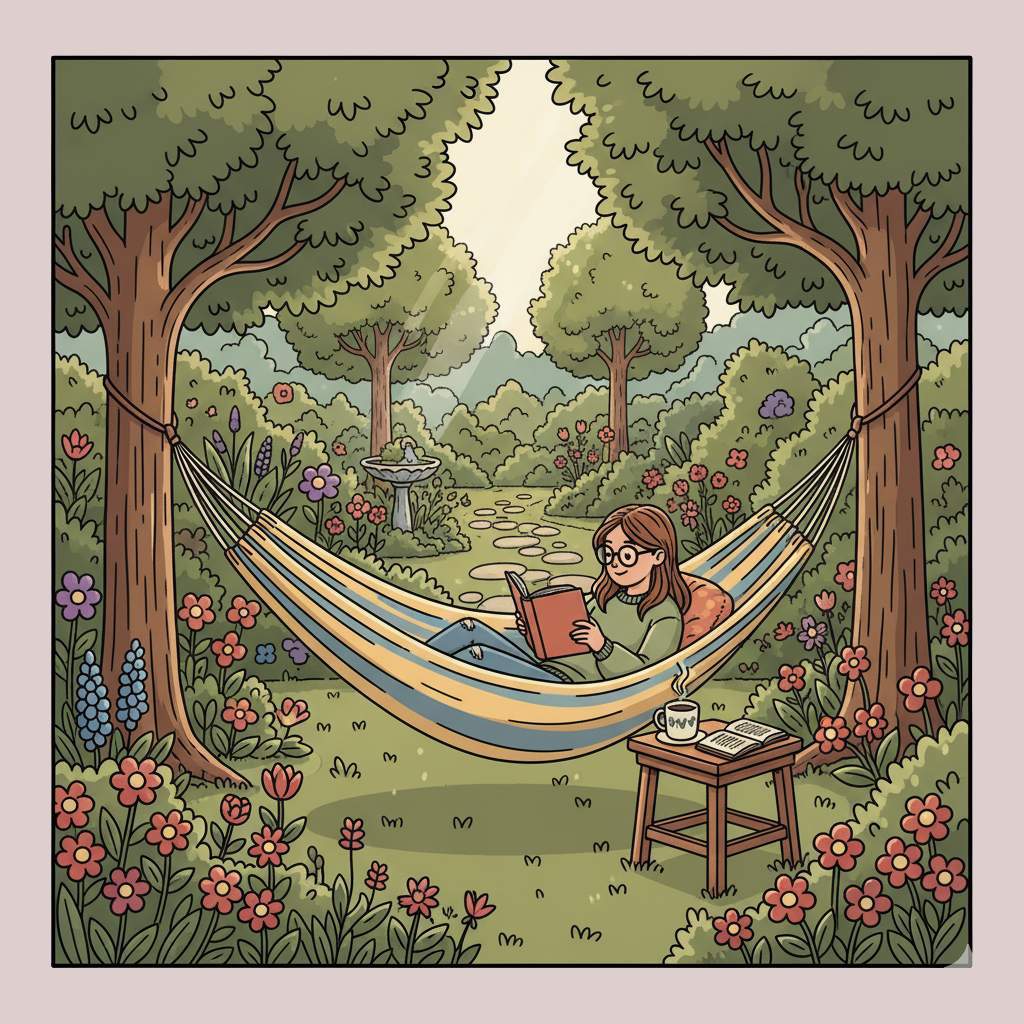The ritual of a good book and a cup of coffee has endured across generations. This pairing forms a perfect counterpoint: one engages the mind, while the other warms the body. A freshly brewed cup steadies the hands as the eyes begin tracing the page, establishing a subtle rhythm of thought. Each sip punctuates a movement in the story and lends the act of reading an understated ceremony.
This connection extends beyond private spaces. Cafés and lounges have long served as venues where books and coffee coexist. The low hum of conversation, the measured sound of brewing, and the aroma of roasted beans create an atmosphere that encourages focus and presence. In such settings, reading maintains a balance between solitude and social energy.

Yet the appeal is not solely practical; it is deeply aesthetic. A steaming cup beside an open book marks time while providing a moment of pause. Whether in a café or at home, reading transforms ordinary minutes into occasions of intentional engagement. This pairing transforms reading into an art form that engages the mind, the senses, and the rhythm of attention, elevating a simple habit into something purposeful and vital.
The Historical Bond Between Books and Coffee
The connection between books and coffee emerged from the early culture of European coffeehouses, where reading, discussion, and intellectual work were woven into daily routine. These establishments offered a setting suited to concentration and exchange, and coffee provided a steady companion to sustained attention. Over time, the act of drinking coffee while reading a book took hold as a practical and cultural pattern.
Coffeehouses as Early Literary Hubs

In seventeenth-century Europe, writers, philosophers, and artists gathered in coffeehouses for discussion and debate. The combination of shared tables, the affordable price of a coffee, and a constant supply of the drink produced conditions in which ideas circulated with unusual freedom. These establishments encouraged conversations across social and professional boundaries and created a community well suited to literary and philosophical discussions outside formal institutions.
Coffee as a Creative Stimulant
Coffee quickly acquired a reputation as a tool for extended intellectual activity. The caffeine provided alertness during long hours of reading and composition, especially with complex texts. Honoré de Balzac relied on it during his intensive writing sessions, and Voltaire reportedly consumed several cups each day while working through drafts and correspondence.

Søren Kierkegaard approached coffee with almost ritualistic precision and prepared each cup to exacting standards before beginning his philosophical work. These routines show the degree to which coffee entered the daily discipline of writers and thinkers. Coffee became a partner in creation, a means to maintain energy and concentration while exploring ideas.
Reading with Coffee at Home
At home, an open book beside a coffee cup becomes an emblem of intellectual curiosity. This section considers how domestic spaces support solitary reading, how rituals emerge around the act, and how the pairing of a book and a cup of coffee acquires its own form of discipline.
Matching Brewing Intensity and Method to Book Type
An astute reader chooses a particular flavor or intensity to set the tempo for the reading session. For example, a concentrated brew establishes the alertness needed for chapters governed by close argument or detail, while a gentler cup steadies the mind for books with atmospheric narratives or gradual shifts.
The brewing method also helps calibrate the sensory connection to the book. A pour-over produces a clear, precise extraction suited to analytical reading; a French press yields a denser cup that aligns with slower movement through the page; while an espresso offers a compact burst of focus for brief sessions that demand strict attention.
Establishing Home Rituals
Ritual gives structure to reading at home. Some readers work best in the morning, when the mind has not yet taken on the demands of the day; others reserve their reading for the evening, when the house has grown still and the pace has slowed down enough. For immersion to be effective, techniques tend to be simple rather than elaborate.

As a defined starting point, a consistent place in the house and a clear boundary from other tasks help the reader approach the text more readily. Coffee contributes to this structure through ritual: the preparation, the first sip, the placement of the cup beside the book. These steps create a stable entry into the reading session and stabilize the reader’s intellectual register to engage with the work.
Reading in Coffee Shops
Public spaces offer a different dimension to the reading experience. Cafés provide a backdrop of ambient activity that subtly enhances attention and steadies the reader’s tempo. This section examines how movement and the presence of others influence the act of reading in a public setting.
The Sensory Atmosphere of Cafés
The atmosphere of a café introduces stimuli that differ from the controlled composure of home. Background sounds and the aroma of brewing coffee create sensory anchors, with varied lighting depending on the time of day. These conditions establish a kind of ambient structure. Instead of distracting the reader, the consistent presence of these elements can support focus by narrowing attention to the page despite the surrounding activity.
Selecting the Ideal Spot
Choosing a place to sit in a café is not simply a matter of comfort because it determines how much control the reader retains over the book despite potential distractions. A window seat offers stable light and a fixed horizon that keeps the visual field predictable, while a corner seat creates a more defined perimeter, reducing the number of directions from which activity can intrude.
Central tables expose the reader to the full movement of the room, which can affect the reader in either direction: stabilize the reading session through steady background motion or erode the reader’s footing if the traffic is irregular. The point is to choose a location that sets clear boundaries so that the reader controls the reading session rather than reacts to the environment.
Social Dynamics and Reading
Reading in public introduces a social dimension that does not exist at home. Other patrons work, converse, or wait for orders, yet their presence does not necessarily compete with the act of reading. Many readers find that the simple fact of being among others creates a steadying influence, as if the room imposes an intrinsic obligation of purposeful activity.
Briefly observing people and catching movements around the café can also serve as a counterbalance to the page by offering a momentary reset. The key is to let the social environment support, rather than distract, the reader’s concentration.
Pairing Coffee with Different Genres

Readers often adjust their pace to match the demands of a book, and coffee can serve as a practical tool for managing that shift. Different genres place different pressures on the mind: some require sharp, immediate focus; others move through slower transitions or depend on brief, concentrated engagement.
Coffee varies in intensity, volume, and extraction method, and those variations offer a way to regulate the reader’s tempo before the session begins. The list that follows examines how the structure of a book influences the kind of coffee that best supports it, not simply as a matter of preference but as a means of meeting the text with the right level of mental readiness.
- Fiction and Espresso: Fast-paced fiction demands a level of alertness that does not falter from page to page. Thrillers, mysteries, and other tension-driven narratives move through sequences that rely on tight internal logic, and a concentrated espresso supports that tempo. The drink offers a sharp lift at the outset and maintains the clarity needed to track shifts, clues, or reversals. The point is not simply to match intense plotting with extreme flavor but to sustain the reader’s attention and promote a firm grasp of detail.
- Poetry and Minimalist Brews: Poetry benefits from a cup that remains restrained and does not intrude on the cadence of the lines. Clean, concentrated brews such as a ristretto or a carefully measured pour-over offer a direct profile that meets the precision of the lines without extending energy past what the poem demands. The form relies on compression, and a drink with a clean, focused taste supports close examination of phrasing and image. The aim is to match the concentrated scale of poetry with an equally concentrated level of alertness.
- Lighthearted Stories and Creamy Coffees: Light fiction such as romance or humor often proceeds through scenes governed by interpersonal rhythm rather than structural complexity. A cream-based coffee suits this pace because it introduces a gradual rise in energy that aligns with material built on tone, dialogue, and steady movement. Lattes and cappuccinos work well in this context since their steadier profile supports reading that depends on tone, conversation, and scene progression rather than rapid developments in plot.
- Nonfiction and Moderate Roasts: Nonfiction demands steadiness across long sections, and a moderate roast supports that requirement. Academic, historical, or analytical books introduce ideas in gradual increments, and the reader benefits from a cup that maintains clarity without abrupt spikes in energy. A medium-roast pour-over or a well-extracted filter brew provides that stability. These coffees offer a level of sharpness sufficient for careful reading yet avoid the intensity that can lead to restlessness during extended sessions.
The Modern Coffee-and-Reading Culture
Coffee has moved beyond the private ritual of the solitary reader. It now thrives in public, social, and digital spaces, marking a transformation in how reading is practiced and shared. Cafés, once peripheral to the literary habit, now serve as informal reading rooms—spaces that blend ambience, background rhythm, and flexible seating to accommodate different reading contexts, from quiet study to lively book-club conversations.

Book Clubs and Literary Gatherings
Book clubs frequently situate themselves within these café environments, drawing coffee into both their rhythm and structure. The shared gesture of ordering and sipping a cup becomes an invitation to reenter the text or shift between dialogue and reflection. Some venues have even embraced this synthesis by curating bookshop-cafés or hybrid cultural spaces, where coffee and literature are not merely paired but presented as interdependent modes of intellectual and sensory engagement.
Digital Reading Routines
Digital reading has not eroded this connection; if anything, it has expanded it. Whether scrolling through an e-book on a tablet, annotating a digital PDF, or drafting notes on a laptop, readers continue to anchor their routines with coffee. The modern café, with its stable WiFi connection, ambient hum, and architectural openness, has become an extension of the private study. In these settings, the pairing of caffeine and text persists across different formats and genres, sustained by the reader’s pursuit of focus and variety.
Aesthetic Representation
On social media, the pairing of book and coffee circulates as a visual ideal: an open book beside a steaming cup, bathed in morning light, curated for subtle admiration. While some are heavily stylized, these images mirror real-life habits, reaffirming that reading remains both a private and publicly expressive act. The coffee cup in such compositions functions less as a lifestyle accessory than as a symbol of heightened concentration, a marker of sustained reading even in the midst of distraction.
Cognitive Function and Caffeine
The influence of caffeine reinforces the ritual’s persistence. In moderate amounts, it heightens alertness and sustains clarity, countering the fatigue that accompanies long reading sessions. However, the effect is nuanced; excessive caffeine can disrupt the balance necessary for effective reading. The reader’s goal is not unbounded stimulation but a state of readiness aligned with the text’s tempo. That balance between clarity and sensory delight, between the movement of ideas and the simple act of drinking coffee, sustains the enduring partnership of coffee and reading in modern culture.
###
The enduring bond between books and coffee is rooted in a shared purpose: the cultivation of a focused and present mind. More than just a practical aid or an aesthetic pleasure, coffee serves as a steadying companion on the journey through a text, its ritual preparing the reader and its caffeine sharpening the faculties. This partnership, honed over centuries in coffeehouses and private studies, persists because it elevates reading from an ordinary habit into a sustained act of intellectual and sensory clarity, becoming a small but vital ceremony in our daily lives.
Further Reading
Coffee date with a book: What should you be reading with your coffee order? by Maria A, UNiDAYS
Wine, Coffee, Tea? What Do You Drink While You’re Reading? by Better Reading
What coffee do you drink when reading? on Goodreads




